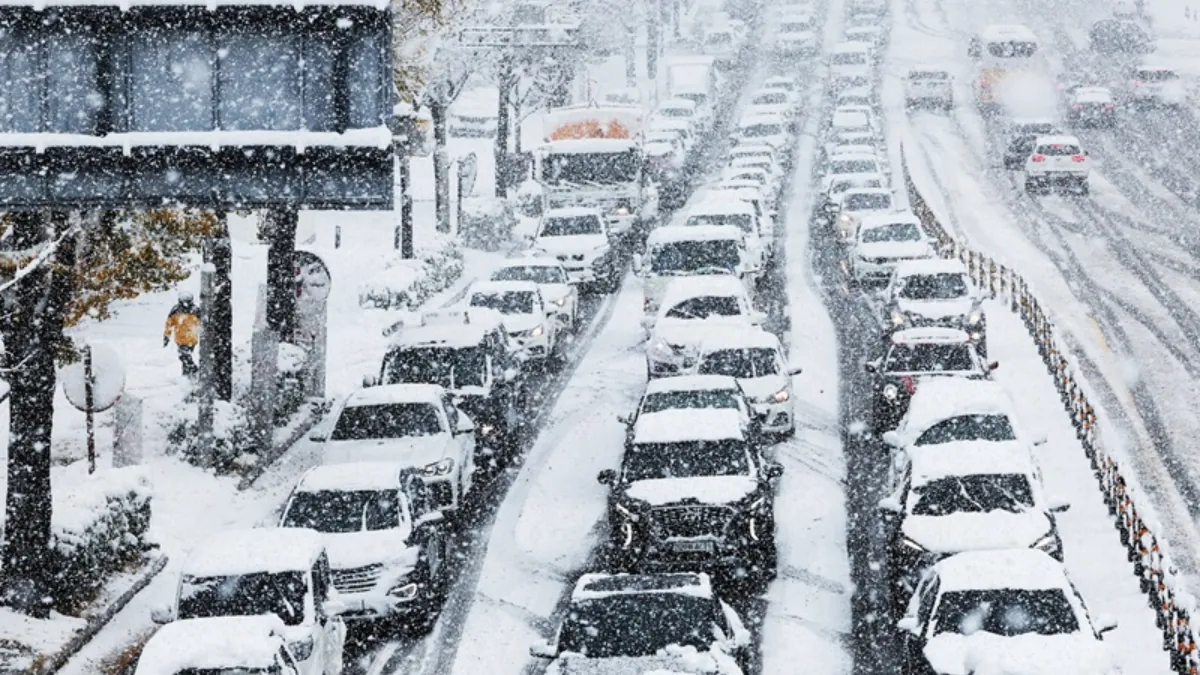Heavy Snowstorm Claims Lives, Disrupts Travel and Power in South Korea
A severe snowstorm wreaked havoc across South Korea on Wednesday, leaving at least three people dead, causing injuries, widespread power outages, and significant travel disruptions.
The Korea Meteorological Administration (KMA) reported record-breaking snowfall in parts of the country, with over 24 centimeters (9.44 inches) accumulating in Seoul and Gangwon by 4 p.m. Gyeonggi Province received 22 centimeters, while Incheon saw 14 centimeters. Other regions, including Jeju Island, experienced snowfall ranging from 2.8 to 20.1 centimeters.
Seoul recorded its highest November daily snow accumulation since 1907, with over 16 centimeters by 8 a.m. Gangwon, which received 21.8 centimeters of snow, witnessed a fatal five-vehicle collision on an expressway at 6:40 a.m., resulting in the death of an 81-year-old passenger. Two drivers sustained severe injuries, and four others reported minor injuries.
In Gyeonggi Province, a 78-year-old man died when his garage roof collapsed as he was clearing snow at 8:40 a.m. Another tragic incident occurred in Hwaseong, where a traffic controller in his 30s was struck and killed by a bus that skidded on a snowy road. Additionally, a collision between an SUV and a truck near Namyangju injured both drivers.
Power Outages and Travel Disruptions
The storm also caused power outages for hundreds of households. In northern Seoul’s Seongbuk District, a tree laden with snow toppled onto power lines, leaving many without electricity. In Gyeonggi’s Gwangju, a utility pole collapse cut power to 230 households, according to the Korea Electric Power Corporation.
Air travel faced severe disruptions, with 146 flights canceled nationwide as of late afternoon. Incheon International Airport saw 71 cancellations, followed by Gimpo with 31, Jeju with 27, and others at regional airports.
Government Response and Safety Measures
To mitigate public inconvenience, local governments ramped up public transportation services. Seoul extended evening rush hour on subway lines 2 and 5 to 8 from 8 p.m. to 8:30 p.m., reducing intervals between trains to three to five minutes.
Morning rush hour services will also remain extended until 9:30 a.m. on Thursday, anticipating continued heavy snow.
President Yoon Suk Yeol directed the Interior and Safety Ministry and the Land, Infrastructure and Transport Ministry to deploy all resources to clear snow and prevent accidents. By 2 p.m., the Interior Ministry elevated the snowfall warning level to “alert,” the second-highest in the four-tier crisis management system.
The Central Disaster and Safety Countermeasure Headquarters has been active since early morning to coordinate the response.
Weather Warnings and Forecast
Heavy snow warnings were issued for parts of Seoul, southern Gyeonggi, Incheon, North Jeolla, and Gangwon, with advisories extended to northern Gyeonggi, mountainous regions of Jeju Island, and several other areas.
The KMA expects central regions and eastern North Jeolla to experience heavy snowstorms through Thursday morning, with snowfall rates of 1 to 5 centimeters per hour.
The agency forecasts an additional 3 to 15 centimeters of snow in the metropolitan area, with up to 25 centimeters in parts of southern Gyeonggi. It urged residents to exercise caution on icy roads and recommended using public transportation where possible.
As South Korea grapples with this extreme weather event, authorities continue efforts to ensure safety and minimize disruptions amid the harsh conditions.

